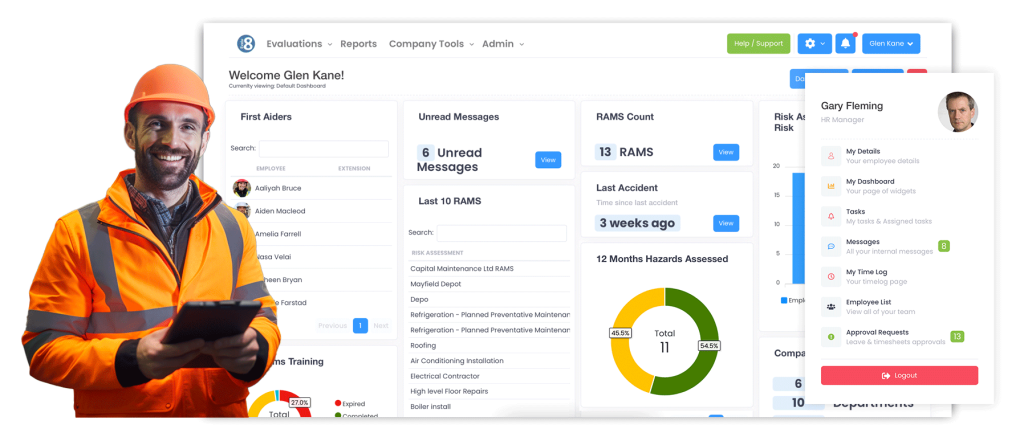ISO 45001 is an internationally recognized standard that sets the framework for effectively managing occupational health and safety (OH&S) in organizations. It provides a systematic approach to identifying and controlling workplace hazards, minimizing risks, and improving overall safety performance. For EHS teams in the UK, understanding the basics of this standard is crucial in ensuring the well-being of employees and compliance with legal requirements.
Understanding the basics of ISO 45001
ISO 45001 was developed to replace the previous standard for OH&S, OHSAS 18001. The International Organization for Standardization (ISO) published ISO 45001 in 2018, ensuring a global consensus on best practices for managing occupational health and safety.
Implementing ISO 45001 can bring numerous benefits to an organization, including improved safety performance, enhanced legal compliance, and increased stakeholder confidence. By adhering to this standard, companies can demonstrate their commitment to providing a safe and healthy work environment for employees, contractors, and visitors.
The origins of ISO 45001
The development of ISO 45001 stemmed from a collaboration between various international organizations and experts in the field of OH&S. The goal was to create a standard that aligns with other management system standards, such as ISO 9001 for quality management and ISO 14001 for environmental management.
Through a series of consultations and feedback from stakeholders worldwide, ISO 45001 was crafted to address the evolving needs and challenges faced by organisations in ensuring occupational health and safety. The standard underwent rigorous review and revision processes to ensure its effectiveness and applicability across diverse industries and sectors.
Key principles of ISO 45001
ISO 45001 is built upon a set of guiding principles that form the foundation of an effective OH&S management system. These principles include the commitment of top management, active participation of workers, and a focus on continuous improvement. With these principles in mind, organizations can establish a culture of safety and mitigate workplace risks.
Furthermore, ISO 45001 emphasises the importance of leadership involvement in promoting a proactive approach to occupational health and safety. By engaging employees at all levels and fostering a sense of ownership towards safety practices, organisations can create a sustainable framework for preventing incidents and ill-health at work.
The importance of ISO 45001 in occupational health and safety
ISO 45001 plays a vital role in promoting workplace safety and protecting employees from occupational hazards. By implementing this standard, organizations can create a safer working environment, reduce accidents and injuries, and enhance overall well-being. Let’s explore some key aspects of ISO 45001.
ISO 45001 is not just a set of guidelines; it is a comprehensive framework that helps organisations of all sizes and industries to establish, implement, maintain and improve their occupational health and safety management systems. This standard is designed to be adaptable to the unique needs and risks of each organisation, ensuring that the safety measures put in place are effective and relevant.
How ISO 45001 improves workplace safety
ISO 45001 provides a systematic approach to identifying hazards, assessing risks, and implementing control measures. This proactive approach helps organizations prevent accidents and incidents before they occur. Through hazard identification, risk evaluation, and effective communication, ISO 45001 ensures that potential hazards are recognized and mitigated.
Moreover, ISO 45001 encourages a culture of continuous improvement in occupational health and safety. By regularly reviewing and updating safety procedures, organisations can adapt to changing circumstances and emerging risks, ensuring that employees are always protected to the highest standard.
The role of ISO 45001 in risk management
Risk management is an essential element of ISO 45001. The standard requires organizations to establish processes for identifying risks and developing appropriate controls. By identifying and evaluating hazards, organizations can effectively manage risks and create a safer working environment. ISO 45001 also emphasizes the need for continuous monitoring and evaluation to ensure that risk control measures are effective.
Furthermore, ISO 45001 promotes a proactive approach to risk management by encouraging organisations to anticipate potential hazards and take preventive action. By fostering a risk-aware culture and involving employees at all levels in the risk management process, organisations can create a safer and more resilient working environment.
The process of achieving ISO 45001 certification
Attaining ISO 45001 certification requires a systematic approach and commitment from the organization. This section outlines the steps involved in obtaining and maintaining certification.
ISO 45001, the international standard for occupational health and safety (OH&S) management systems, is crucial for organisations looking to prioritise the well-being of their employees and create a safe working environment. Achieving this certification is not just a badge of honour but a strategic decision that can enhance reputation, increase trust among stakeholders, and improve overall performance.
Steps towards ISO 45001 certification
Implementing ISO 45001 involves several key steps, including conducting a gap analysis, developing an OH&S management system, and establishing measurable objectives. EHS teams must ensure that all requirements of the standard are met and documented. External audits are then conducted to assess compliance with ISO 45001 and verify the effectiveness of the OH&S management system.
Organisations embarking on the journey towards ISO 45001 certification often find the process to be a transformative experience. It requires a cultural shift towards a safety-first mindset, where every individual within the organisation takes responsibility for identifying hazards, assessing risks, and implementing controls to mitigate them. This shift not only leads to compliance with the standard but also fosters a culture of continuous improvement and employee engagement.
Maintaining ISO 45001 certification
ISO 45001 certification is not a one-time achievement. Organizations must continuously monitor and improve their OH&S management system to maintain certification. Regular internal audits, management reviews, and participation in external surveillance audits are essential for keeping the certification valid and demonstrating ongoing commitment to safety.
Furthermore, maintaining ISO 45001 certification requires a proactive approach to risk management and a willingness to adapt to changing circumstances. By staying abreast of emerging risks, technological advancements, and regulatory updates, organisations can ensure that their OH&S management system remains effective and relevant in safeguarding the well-being of their workforce.
The impact of ISO 45001 on businesses
Implementing ISO 45001 offers numerous benefits to organizations, but it also comes with its own set of challenges. Understanding these advantages and obstacles is essential for EHS teams considering ISO 45001 implementation.
Benefits of ISO 45001 for organizations
ISO 45001 can help organizations improve their OH&S performance by minimizing workplace accidents and injuries. This, in turn, leads to increased productivity, reduced absenteeism, and improved employee morale. ISO 45001 also enhances an organization’s reputation, fostering trust with stakeholders and attracting potential customers who prioritize safety.
Challenges in implementing ISO 45001
While the benefits of ISO 45001 are significant, implementing the standard can present challenges for organizations. Some common obstacles include building employee awareness and involvement, incorporating OH&S considerations into existing processes, and ensuring compliance with legal and regulatory requirements. Overcoming these challenges requires a dedicated effort from EHS teams and effective communication throughout the organization.
Future trends in ISO 45001
As occupational health and safety evolve, ISO 45001 is expected to adapt to emerging needs and changing workplace dynamics. Understanding future trends in this standard is essential for EHS teams to stay ahead of the curve.
The evolving nature of ISO 45001
ISO 45001 is designed to be a dynamic standard, continuously evolving to address emerging challenges and industry best practices. As new technologies, workplace trends, and hazards emerge, ISO 45001 will continue to provide updated guidelines and requirements for OH&S management.
ISO 45001 and the future of occupational health and safety
ISO 45001 represents the ongoing commitment to occupational health and safety in organizations and serves as a catalyst for further improvements in OH&S management. With increasing emphasis on worker well-being, ISO 45001 will likely play a crucial role in shaping the future of occupational health and safety practices.
Conclusion
ISO 45001 is a comprehensive standard that establishes the framework for effective occupational health and safety management in organizations. By understanding the basics of ISO 45001, its importance in workplace safety, the process of achieving certification, and the impact on businesses, EHS teams can make informed decisions and drive continuous improvement in occupational health and safety.
See the quick demo now
Before we show you the quick demo, we need to make sure you are a real person.
“It has brought all of our health and safety under one roof and made it easy for me to see all the data”




